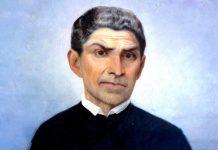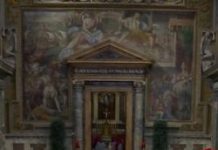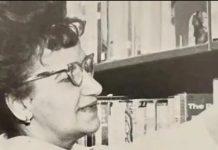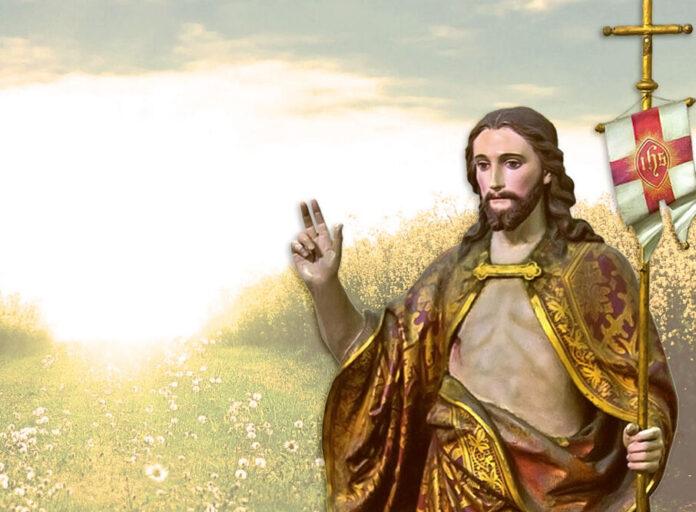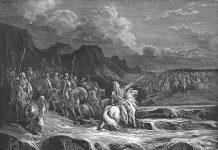In the midst of darkness, in the great ‘night’ of history, ‘the Light shone in the darkness, and the darkness could not overcome it’. out of the shadows of death, the Resurrected Christ shines brightly!
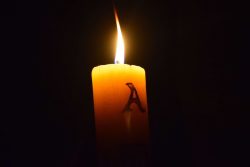
Newsroom (20/04/2025 14:00, Gaudium Press) Night is a symbol of the kingdom of darkness. Surrounded by darkness, the world seems bound by unbreakable chains. On this night, the One who proclaimed Himself ‘the Light of the world’ (Jn 8:12), after being betrayed and handed over to His enemies, lies motionless in a tomb, apparently without any power. For this reason, the Holy Church celebrates the most solemn of all her ceremonies in the middle of the night. In the midst of darkness, in the great ‘night’ of history, ‘the Light shone in the darkness, and the darkness could not overcome it’ (Jn 1:5). The greatest event was realized, one of the greatest mysteries of our Faith, which is relived today through the Liturgy: out of the shadows of death, the Resurrected Christ shines brightly!
Even in our day, the Redeemer, in His Mystical Body, seems to be surrounded by the darkness of a world at war with God and which wants to bury the immortal life of the Holy Church forever in oblivion and ignominy.
However, like her Divine Spouse, the Holy Church will rise luminous, not from a tomb, but from within our hearts. And the greater the efforts to destroy her, the more glorious her triumph will be!
Indeed, as long as there are faithful souls in the world, they will raise their voices to the stars, proclaiming in a loud voice: ‘O truly holy night, when Heaven unites with Earth for the supreme combat between Life and Death, Good and Evil! Behold our burning hearts. From them rise the flames that tear through the darkness and long to fulfil the Saviour’s words: ‘I have come to set the earth on fire, and how I wish it were already burning’ (Lk 12:49)’.
Preparing the Paschal Candle
The Paschal Candle is a symbol of Our Lord Jesus Christ and for this reason it bears the marks that represent the stigmata with which His most sacred Body was laid in the tomb.
However, as the Liturgy will sing, it is also a symbol of the Holy Catholic Church, prefigured by the pillar of fire that marched at the head of Israel and guided the chosen people across the Red Sea. As the Mystical Body of Christ itself, Holy Mother Church bears these glorious marks as trophies.
For this reason, the following will be engraved on the Candle: the glorious Cross of our Redemption; the first and last letters of the Greek alphabet, ‘Alpha’ and ‘Omega’, signifying that Jesus Christ is the beginning and end of all creation; and the numerals of the current year, since it is because of Our Lord that time passes on this earth. The celebrant will say: “Christ, yesterday and today, Beginning and End, Alpha and Omega. To Him be time and eternity, glory and power for ever and ever. Amen.”
The nails that will be driven in next represent the Saviour‘s wounds. They are made with grains of incense in memory of the perfumes prepared by the Holy Women, and they teach us that all the sorrows of the Saints, united to those of the Redeemer, ascend like an aromatic cloud to the throne of the Most Holy Trinity.
The celebrant applies five grains of incense in the shape of a cross to the Candle, saying:
“For His holy wounds,
your glorious wounds,
may Christ the Lord
protect us
and keep us. Amen.”
The flame that will glow in the candle represents the life of the Risen Christ, who, as Head of the Church, transmits His own life to each of its members. This flame also indicates that faith in the Resurrection is already shining throughout the Church.
It is important to note that the flame, coming from the blessed fire, is transmitted to the Paschal Candle by means of a small candle, symbolizing that, in the nights of history, the light and holiness of the Church subsists through the fidelity of a few, sometimes a single chosen soul, as was that of Our Lady in the solitude of Holy Saturday!
Finally, the celebrant lights the Paschal Candle with new fire, saying: “May the light of the risen Christ resplendent dispel the darkness of our hearts and minds.”
Procession with the Paschal Candle
Delivering the chosen people from the slavery of Egypt, God led them by a pillar of fire through the sea and the desert towards the Promised Land. By freeing us from sin and death with his Resurrection, Our Lord Jesus Christ broke the shackles that enslaved us to the world and gave us Holy Mother Church as our guide, which leads us to the fulfilment of God’s promises.
This glorious journey of the Mystical Bride of Christ towards the full realization of the Kingdom of God is represented in our entrance into the temple. Guided by the light of the Holy Church, we will meet the heavenly Jerusalem, ‘coming down from heaven, sent by God’ (Rev 3:12).
The procession will stop three times to acclaim the light of Christ, in honour of the Holy Trinity. And the candles will be lit successively, signifying that we have received from this light the mission to transmit it to the whole world.
Easter proclamation
Such is the Church’s joy at the Resurrection of Our Lord Jesus Christ that she is not content to show it only by the sacred ornaments, the adornment of the temple or the brilliance of the lights. Her heart exults and a true song of love overflows from her lips.
In the Easter Proclamation, we should recognize the voice of the Holy Church which, intoxicated with enthusiasm for Christ’s victory, raises her triumphal hymn to Heaven. Let us rejoice with her, for in Christ’s triumph our own victory is enshrined.
Glory
The Holy Church listens enthralled to the story of the marvelous deeds done by God to the people of Israel. But she knows that all this was only the prelude to the work of salvation, for it is our Lord Jesus Christ who fulfils it in its entirety.
After hearing the voices of the Old Testament, it is now the Church’s turn to raise her song of praise and triumph. At the sound of the bells, Angels and Blessed Ones descended from Heaven join our voices in proclaiming to the whole world with enthusiasm: Christus vincit, Christus regnat, Christus imperat! (Christ conquers, Christ reigns, Christ commands!)
If the predominant note of Lent was penance in preparation for the coming Easter feasts, now that the darkness of sin has been overcome, all of us, redeemed by the Redeemer’s Blood, can sing a new song, as Moses and the Israelites did after crossing the Red Sea: ‘I want to sing to the Lord, for He has made his glory shine’ (Ex 15:1).
During the Easter season, this song is summarized in a single Hebrew word, which literally invites us to praise God: ‘Alleluia’. Omitted for forty days, the ‘Alleluia’ returns to the Liturgy on this Holy Night, sung solemnly three times before the Gospel, each time using a higher tone than the last, to express the overflowing joy of the whole Church at the glory of the Resurrection.
The Gospel
One detail counterpoints the prevailing joy: the candles that accompany the Gospel to the ambo and remain there while it is proclaimed, will not be present today; only incense will be used to revere the book of the Holy Gospels. This is an allusion to the holy women who went to the tomb with perfumes and balms, but faith in the Resurrection was not yet shining in their souls. The incense recalls the perfumes, the absence of candles means that they had no faith.
Baptismal Liturgy
Through Baptism we ‘die to sin once for all’ (Rom 6:10), to become like our Lord Jesus Christ. And with his Resurrection, He also conquers our glory (d. Col 3:4).
The Liturgy invites us to renew the promises of our Baptism at this Holy Vigil, burying under the sanctified waters ‘the old man and his ways’ (Col 3:9) and putting on the new man, so that we may be beacons of holiness throughout the world.
Eucharistic Liturgy
The Easter Vigil concludes with the Eucharistic Liturgy. The renewal of the Sacrifice of Calvary proclaims the triumph of the One Who, rising from the dead, entered heaven ‘once for all’ (Heb 12) to intercede ‘always on our behalf’ (Heb 7:3).
The Holy Catholic Church is the only indestructible institution, because it shares in the immortality of its Founder. May this holy night cement in our souls the ardent conviction, the unshakeable faith, the invincible trust that the gates of hell will never prevail against us (c. Mt 16:18), for we are members of the Mystical Body of the Risen Undefeated.
Compiled by Sandra Chisholm


















